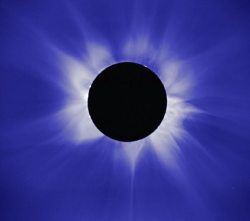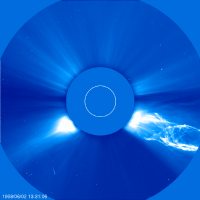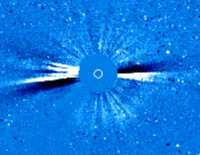Giant eruptions
from the Sun
By Nancy Crooker
Boston University
 |
| |
This
solar eclipse was photographed
in India on February 16, 1980.
Image courtesy the High Altitude
Observatory of the National
Center for Atmospheric Research. |
| Should
a modern Joshua stop the moon in its tracks
during a total solar eclipse so
that for hours on end we could watch the
hazy corona surrounding the Sun, we would
see an amazing phenomenon called a "coronal
mass ejection"—CME, for short. We would see
a huge bubble of coronal material form and
then leave the Sun, heading out into space.
We would have witnessed the birth of a space
storm.
CMEs
were recognized as a common solar phenomenon
in the 1970s when a technological Joshua
called a "coronagraph" flying on an orbiting
laboratory called "Skylab" held an artificial
moon fixed in front of the Sun and inaugurated
an era of routine CME observations. A coronagraph
simulates a total solar eclipse by blocking
the bright light from the Sun with a disk.
To see CMEs, a coronagraph must be above
the atmosphere, where the sky is black, as
it is at ground level during a solar eclipse,
so that the bright blue light of the atmosphere
does not drown out the light from the CMEs.
 |
| |
A CME captured
by the LASCO coronagraph onboard
the SOHO spacecraft.
Image courtesy of SOHO/LASCO
consortium. SOHO is a project
of international cooperation
between ESA and NASA. |
|
Since
routine CME observations began, it has
taken scientists years more of research
to establish that CMEs produce space storms,
and to significantly improve means of predicting
them. Understanding and predicting space
storms is important to society because of
our rapidly increasing dependence upon technology
that space storms affect. Space storms can
cripple satellites, interrupt communications
systems, and cause power failures. We now
understand that the key storm ingredient
in a CME is its magnetic field, which is
coiled inside it like a slinky. To appreciate
why coiled magnetic fields bring stormy space
weather, one needs to know something about
fair weather in space-namely, the background
flow called the "solar wind" and the configuration
of its imbedded magnetic fields.
Interplanetary space is filled with the
solar wind, the Sun's expanding atmosphere
of high-speed charged particles, which sets
the fair weather backdrop for CMEs. Unlike
weather on Earth, however, the important
parameter is not the wind itself but its
imbedded magnetic field, which comes from
the Sun. Eugene Parker (Univ. of Chicago),
the scientist who predicted the existence
of the solar wind, recognized that the solar
wind would draw the solar field out into
space as if it were frozen to the flow. Further,
he deduced that in the ecliptic plane (that
is, the plane in which the planets rotate
about the Sun), the Sun's rotation about
its own axis would cause the field lines
to radiate away from the Sun in a spiral
pattern like water from a rotating garden
sprinkler. Subsequent spacecraft observations
have proven Parker correct.
For Earth, the gently spiraling magnetic
fields carried by the solar wind herald fair
weather because Earth's magnetic shield,
the magnetosphere, deflects them. The magnetosphere
is a tadpole-shaped obstacle in the solar
wind created by Earth's magnetic field. At
the head of the tadpole, where it faces into
the wind, Earth's magnetic field points northward,
perpendicular to the spiral field. Fields
perpendicular to each other, for the most
part, slip past each other. Antiparallel
fields, on the other hand, connect when they
meet. Thus any southward pointing fields
in the solar wind link with Earth's field,
and like newly connected pipes, allow solar
wind particles and energy to pour into the
magnetosphere. The magnetosphere's response
is a geomagnetic storm, complete with auroral
displays and potential problems for satellites,
power grids, and radio transmission. What
heralds bad space weather for Earth, then,
are southward fields in the solar wind-and
the stronger they are, the worse the storm.
What turns CMEs into space storms, then,
is their strong, coiled fields, which nearly
guarantee some portions pointing southward.
Moreover, for those CMEs that travel faster
than the background wind, the background
fields ahead of them become strong through
compression, strengthening any southward
fluctuations there.
 |
| |
A halo CME recorded
by the LASCO coronagraph onboard
the SOHO spacecraft.
Click on the image to see a
movie of this event. Image
courtesy of SOHO/LASCO
consortium. SOHO is a project
of international cooperation
between ESA and NASA. |
|
Viewed
from the front, a CME in a coronagraph
looks like a uniform halo around the disk
blocking the Sun, hence the name, "halo CME." Halo
CMEs have been difficult to detect because
they are not as bright as CMEs viewed from
the side. However, recent technological advances
have made them routinely detectable with
the coronagraph on the SOHO spacecraft. This
ability will be a boon for space weather
predictions. In a retrospective study of
data from December 1996 to June 1997, nine
halo CMEs were detected, and all nine produced
geomagnetic storms. Only three additional
storms occurred which could not be associated
with halo CMEs.
This strong correspondence is remarkable
in view of past prediction capabilities.
Traditionally solar flares have been used
to predict storms, and the failure rate has
been high. Flares are brightening events
on the Sun primarily at wavelengths shorter
than visible light. Viewed in x-rays, for
example, flares make the Sun look like a
constantly sparkling jewel because they occur
so frequently. The brightest flares have
been used for storm predictions, and these
often do accompany CMEs; hence their predictive
capability. But many CMEs occur with no apparent
associated flares or with flares so weak
that they go undetected in standard monitoring
techniques. Now that we can see the CMEs
themselves, there is no need to depend upon
such an unreliable predictor as a flare.
From an ethereal sight to a source of technological
problems, CMEs continue to fascinate scientists.
How they form, why they occur, and what makes
some of them very fast are walls in our understanding
that have yet to come tumbling down.
Printed with permission by:
World Radio TV Handbook
PO Box 7373
Milton Keynes
MK12 5ZL
United Kingdom |

